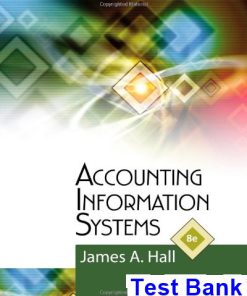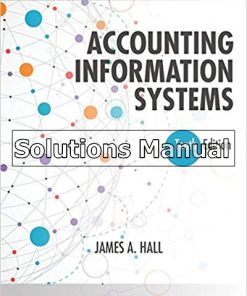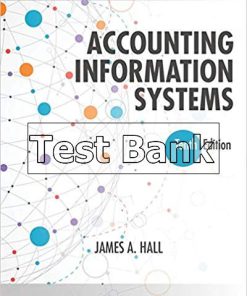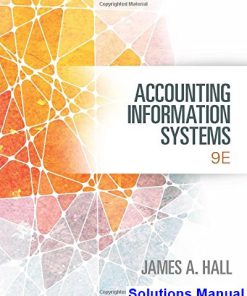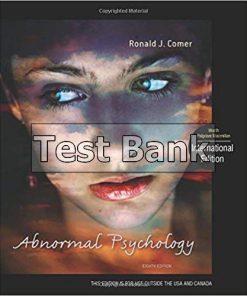Accounting Information Systems 7th Edition Hall Test Bank
You may also like
Accounting Information Systems 7th Edition Hall Test Bank
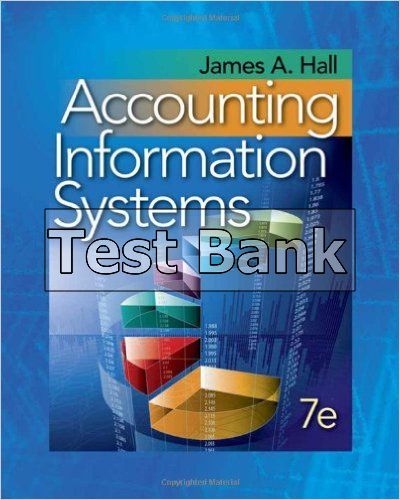
Product details:
Part I Overview of Accounting Information Systems
1(150)
The Information System: An Accountant’s Perspective
3(38)
The Information Environment
4(11)
What Is a System?
5(2)
An Information Systems Framework
7(2)
AIS Subsystems
9(1)
A General Model for AIS
10(4)
Acquisition of Information Systems
14(1)
Organizational Structure
15(9)
Business Segments
15(1)
Functional Segmentation
16(3)
The Accounting Function
19(1)
The Information Technology Function
20(4)
The Evolution of Information System Models
24(7)
The Manual Process Model
24(1)
The Flat-File Model
25(2)
The Database Model
27(1)
The REA Model
28(3)
Enterprise Resource Planning Systems
31(1)
The Role of the Accountant
31(2)
Accountants as Users
32(1)
Accountants as System Designers
32(1)
Accountants as System Auditors
32(1)
Summary
33(8)
Introduction to Transaction Processing
41(70)
An Overview of Transaction Processing
42(2)
Transaction Cycles
42(2)
Accounting Records
44(9)
Manual Systems
44(6)
The Audit Trail
50(1)
Computer-Based Systems
51(2)
Documentation Techniques
53(14)
Data Flow Diagrams and Entity Relationship Diagrams
53(4)
System Flowcharts
57(7)
Program Flowcharts
64(3)
Record Layout Diagrams
67(1)
Computer-Based Accounting Systems
67(7)
Differences between Batch and Real-Time Systems
68(1)
Alternative Data Processing Approaches
69(2)
Batch Processing Using Real-Time Data Collection
71(3)
Real-Time Processing
74(1)
Data Coding Schemes
74(5)
A System without Codes
74(2)
A System with Codes
76(1)
Numeric and Alphabetic Coding Schemes
76(3)
Summary
79(1)
Appendix
80(31)
Ethics, Fraud, and Internal Control
111(40)
Ethical Issues in Business
112(5)
Business Ethics
112(1)
Computer Ethics
112(4)
Sarbanes-Oxley Act and Ethical Issues
116(1)
Fraud and Accountants
117(11)
Definitions of Fraud
117(1)
The Fraud Triangle
118(1)
Financial Losses from Fraud
119(1)
The Perpetrators of Frauds
120(2)
Fraud Schemes
122(6)
Internal Control Concepts and Techniques
128(9)
SAS 78/COSO Internal Control Framework
132(5)
Summary
137(14)
Part II Transaction Cycles and Business Processes
151(244)
The Revenue Cycle
153(64)
The Conceptual System
154(16)
Overview of Revenue Cycle Activities
154(6)
Sales Return Procedures
160(3)
Cash Receipts Procedures
163(3)
Revenue Cycle Controls
166(4)
Physical Systems
170(1)
Manual Systems
171(6)
Sales Order Processing
171(3)
Sales Return Procedures
174(1)
Cash Receipts Procedures
174(3)
Computer-Based Accounting Systems
177(13)
Automating Sales Order Processing with Batch Technology
177(1)
Keystroke
178(2)
Edit Run
180(1)
Update Procedures
180(1)
Reengineering Sales Order Processing with Real-Time Technology
180(1)
Transaction Processing Procedures
180(2)
General Ledger Update Procedures
182(1)
Advantages of Real-Time Processing
183(1)
Automated Cash Receipts Procedures
183(2)
Reengineered Cash Receipts Procedures
185(1)
Point-of-Sale (POS) Systems
185(1)
Daily Procedures
185(2)
End-of-Day Procedures
187(1)
Reengineering Using EDI
187(1)
Reengineering Using the Internet
188(1)
Control Considerations for Computer-Based Systems
188(2)
PC-Based Accounting Systems
190(1)
PC Control Issues
190(1)
Summary
191(1)
Appendix
192(25)
The Expenditure Cycle Part I: Purchases and Cash Disbursements Procedures
217(48)
The Conceptual System
218(12)
Overview of Purchases and Cash Disbursements Activities
218(7)
People also search:
an accounting information system is defined as a system that
an accounting information system has five basic components
accounting information systems book
control and accounting information systems chapter 7
accounting information system chapter 7
financial accounting information for decisions pdf


